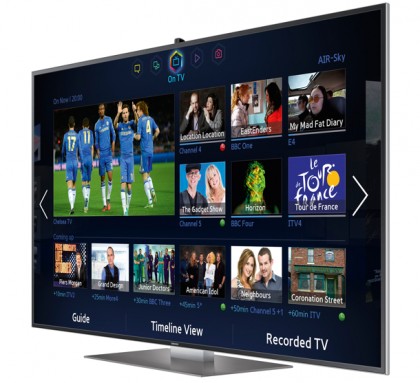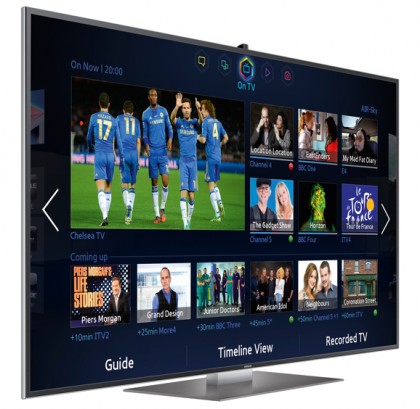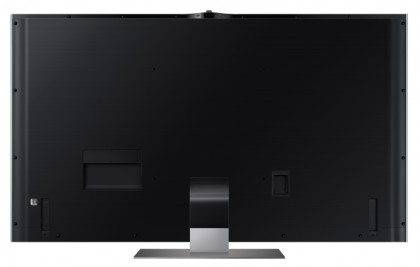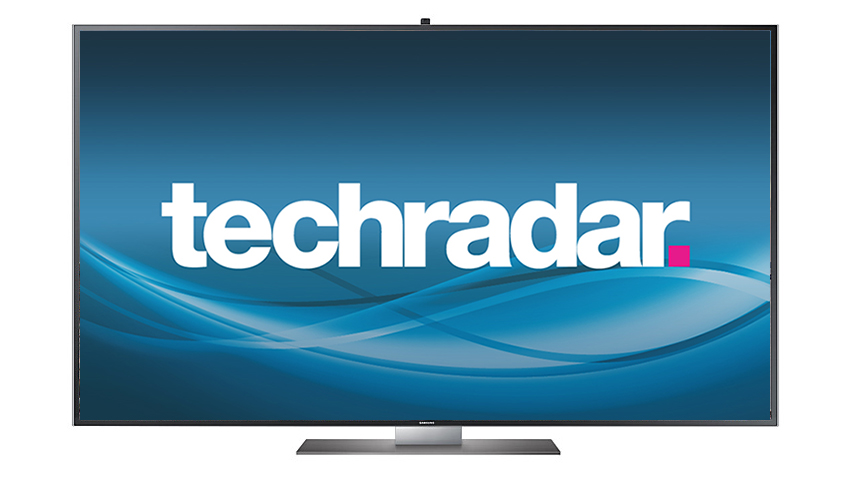TechRadar Verdict
The UE55F9000 isn't necessarily better than Sony's X9005A 4K models, but it's certainly just as good, simply offering a surprisingly different approach to the undoubted joys of UHD.
Pros
- +
Great price for UHD
- +
Stunning next-gen pictures
- +
Superb catch-up TV service
- +
Futureproof
Cons
- -
Some presets aren't helpful
- -
Some Smart interface issues
- -
Audio could be better
- -
3D motion issues
Why you can trust TechRadar
The 4K/UHD TV resolution isn't just upon us, it's also already getting competitive.
For hot on the heels of Sony's 65in 4K trailblazer, the KD-65X9005A, comes Samsung's 55-inch UE55F9000.
And after initially launching at the same £4,000 price as Sony's 55-inch 55X9005A, within days it had its price slashed to just £3,300. But does this value appeal mean Samsung's TV is compromised in performance terms compared with the outstanding X9005As?
Samsung's slender model represents a neat contrast with Sony's deliberately huge 4K design, and in specification terms it doesn't seem to hand any advantage to the Sony model, offering a high potential motion rate of 1000Hz that compares favourably – on paper, at least - with Sony's Motionflow 800 system.
The UE55F9000 also has a seriously sophisticated Smart TV service that's uniquely well set up where video streaming services are concerned, and not only does it join Sony's models in offering 3D, it is excitingly the first UHD TV that upscales HD 3D content to a UHD resolution.
The UE55F9000 marks the first 55in UHD TV we've tested, raising questions over whether you can really appreciate UHD at such a relatively small (well, compared with the 65in and 84in UHD/4K TVs we've seen previously!) screen size. The F9000 series is also the first point in Samsung's 2013 range where the brand applies local dimming technology to its edge LED lighting system.
If you don't want to futureproof yourself with a UHD TV, the next model down in Samsung's range is the F8000 series. These are outstanding Full HD performers despite not using local dimming. A step further still down are Samsung's F7000 models, which feature less high-powered motion processing and a less sophisticated dynamic contrast system.
As for rivals, really the only close alternative right now is Sony's X9005A series of 4k models – unless you're willing to consider leaping up to a hugely expensive 84in screen like LG's £17k 84LM960V.

Features
The headliner in this section has to be the UE55F9000's UHD native pixel count of 3840x2160. This delivers four times the native resolution of a normal full HD TV to hopefully give images a much denser, sharper and more detailed look – even in a relatively 'small' 55in screen environment – than anything you can get with a normal HD TV.
Obviously there's a fairly major issue where UHD is concerned right now in that there are precious few – practically none, actually – native 4K/UHD sources around to get the maximum effect from such a high-resolution TV. But all the indications are that 4K/UHD content is coming sooner than you might think.

In the mean time, of course, the UE55F9000 is equipped with enough processing power to convert high definition and even standard definition sources to the screen's UHD resolution, hopefully giving them an extra touch of quality you don't get with an HD screen. Assuming the upscaling processing works well, of course.
UHD 3D
Samsung still refuses to entertain the idea of adopting the passive 3D technology developed by its great rival, LG. Which means the UE55F9000's upscaling processing also has to work in the 3D domain, delivering our first experience of a UHD-resolution 3D image. This is pretty exciting in our opinion - despite consumers' apparent indifference to 3D.
Samsung supports its intriguing 3D playback by providing two pairs of active shutter 3D glasses free with the TV.
The UE55F9000's slender, attractive, glass-covered frame houses an edge LED lighting system. But unlike the F8000 models one-step down Samsung's current TV range, this lighting array is accompanied by a local dimming system, whereby segments of the LEDs down the screen's left and right sides can have their brightness adjusted individually. Experience and simple common sense suggest that this should significantly improve the UE55F9000's potential contrast performance.
E-motion-al
When it comes to UHD pictures, you really don't want their remarkable clarity and sharpness to be spoiled by motion blur. So it's promising to find the UE55F9000 enjoying a 1000Hz-like motion system, delivered by a combination of a native 200Hz panel, a scanning backlight, and motion interpolation processing.
Samsung doesn't pursue the endorsement of the independent Imaging Science Foundation pro picture calibration group, but that certainly does not mean the UE55F9000 doesn't have bags of calibration flexibility. On the contrary, with its colour management, gamma management and white balance tools, as well as its extensive controls over most aspects of its video processing, you can get its pictures to look pretty much exactly how you want them to look - including meeting film industry standards if that's what you like.
It might, perhaps, have been nice if Samsung had provided more clear-cut controls over its UHD upscaling engine, as Sony does with its X9005A models. But the reality is that the sharpness/noise reduction/etc settings still give you a solid amount of control over how the upscaled images look.
Smart TV
Its other highlight feature area is its Smart TV interface, which is for our money the most advanced in the TV world right now. Its strongest asset is the way it delivers all the main UK catch up TV services: the BBC iPlayer, ITV Player, 4OD and Demand Five. Samsung is the only brand currently offering all of these services.
They're joined, moreover, on the online video front by Netflix, LoveFilm, Blinkbox and a variety of other lesser known but still in some cases really content-rich services.
There's a wide variety of other apps at your disposal too, though many of these are of questionable value/quality. Video streaming remains king where Smart TV services are concerned.
The UE55F9000 allows playback of video, photo and music files from USB storage devices or networked, DLNA-capable PCs, and provides content sharing and control via secondary Android and iOS devices.
Hub, hub hooray
The multi-hub presentation of the Smart TV system is attractive too, and also well worth pointing out is the way the TV can remember your viewing habits and start to make recommendations accordingly. It takes around three months of normal TV use before this system really comes into its own, but it's much more sophisticated than any other recommendation systems currently being employed by TVs.
Two final features of the UE55F9000 to draw on are its use of an external connections box – a rather handy idea it seems to us, as it means you only have one cable running into the screen – and its future-proofness against the as yet unratified HDMI 2.0 connection standard that enables 4K/UHD signals to be delivered.

At the moment we only have Samsung's categorical assurances about this future proofing, but it's easier to see how necessary hardware updates could be made to the UE55F9000 than it is with Sony's X9005 models.
John has been writing about home entertainment technology for more than two decades - an especially impressive feat considering he still claims to only be 35 years old (yeah, right). In that time he’s reviewed hundreds if not thousands of TVs, projectors and speakers, and spent frankly far too long sitting by himself in a dark room.

